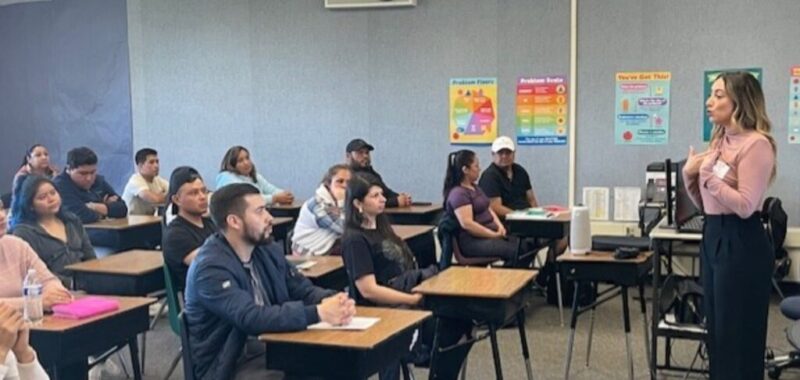
Adult education students at Huntington Beach Adult School in the Huntington Beach Union School District
Credit: Jorge Van Dyck / Huntington Beach Adult School
There’s an incredibly important program that takes place in the back lots of a number of K-12 school sites.
Adult Education serves students aged 18 and over in English as a second language (ESL), citizenship, adult basic education/adult secondary education (diploma and GED), and short-term career technical Education (CTE).
But their services to the schools they are housed in and the surrounding community are so much more. In fact, adult education staff and supporters have been espousing the benefits associated with Community Schools before the term became popular. They are that link schools don’t know they have to make sure parents know about and attend their District English Language Advisory Committee to help plan how funds will be used to support English learners, and they are often the link to immigration attorneys, financial literacy programs and a bridge to the training that so many parents of K-12 students end up needing.
UPCOMING ROUNDTABLE
Adult education: Overlooked and underfunded
Adult education classes offer a lifeline for Californians who want to get their high school diploma or GED, acquire training for a career, hone their English skills or study for their citizenship test. These classes can dramatically improve the quality of life for adults — and their children.
As the state grapples with tighter budgets, join EdSource’s Emma Gallegos and Zaidee Stavely and a panel of experts on July 25 at 2 p.m. to examine the unique potential of adult education and discuss what lies ahead.
Save your spot
Adult education also benefits students in the K-12 system. To put it simply, our immigrant students have immigrant parents, and assisting parents in learning the language and the school system’s processes in an English learner class is bound to pay off for the child as well. Also, offering short-term career technical education classes for those same parents to transition into once they have a grasp of the language (like in this medical assistant IET – integrated education and training program) is ultimately going to provide a more financially stable family structure that, again, benefits the child attending our K-12 schools. Finally, no matter how many redundant systems we put into K-12, students do drop out, and adult schools provide a place for that student to come back and finish their diploma or high school equivalency.
Yes, these folks are flexible, and their services complement the goals of our K-12 districts, which is likely why a decision was made a long time ago to house adult education within these institutions.
Unfortunately, flexibility is also a sore spot for adult educators. When the state budget gets pinched, adult education feels it first. In 2008-09, that meant cuts of 15% and 20%, and when the state government allowed for categorical programs — which previously could only be used for specific purposes — to be used flexibly, adult education funds were used to keep K-12 programs going, and many adult programs were decreased or even lost. By 2013-14, the Legislature introduced a package to eliminate school district categorical programs that targeted funding for adult education but salvage the adult education system by requiring districts to move into consortia beginning in 2015-16, joining community colleges and K-12 adult schools together in offering non-credit adult education. Schools moving to this system were asked to maintain 2011-12 levels of spending on adult education, which by then was at about 50% of 2008-09 levels.
So, it is understandable when an adult educator winces at the word “flexibility” and would rather it not even be mentioned in these bleak financial times. But the good news for California, its schools, and communities around those schools, is that California still supports its adult education system like no other state. The budget for adult education has actually grown in recent years. And, despite a recent Legislative Analyst Office report second guessing the funding structure it helped to create, adult educators feel the more they let folks know about the incredible wraparound services they provide for adults and children in the K-12 districts that are lucky enough to house them, then the more likely it will be for that elusive respect to be gained and programs sustained into the distant future.
The fundamental tasks of adult education are widely agreed upon and supported, even if many K-12 educators don’t know exactly what happens in those beige portables at the edge of their campus.
As alluded to at the start, those classes for adults are often tucked away in corners of larger campuses that are hard to find, and some forget they are there, and that’s generally OK with those who work there, since adult school employees know the value of their work is about so much more than that; they are flexible. They know that being right there on the campus where adult school parents’ kids attend is a great start.
Going back and forth between different sets and shades of beige portables on the four different campuses where Huntington Beach Adult School provides ESL classes, I have an appreciation for the often slighted portable and feel compelled to steal from William Carlos Williams to bring an end to this musing on the value of adult education.
So much depends
upon the beige portables
at the edge of campus,
glazed in flood lights,
filled with adult students.
 Credit: Jorge Van Dyck / Huntington Beach Adult School
Credit: Jorge Van Dyck / Huntington Beach Adult School•••
Philip Villamor is an assistant principal at Huntington Beach Adult School, which is a part of the Huntington Beach Union High School District.
The opinions expressed in this commentary represent those of the author. EdSource welcomes commentaries representing diverse points of view. If you would like to submit a commentary, please review our guidelines and contact us.

